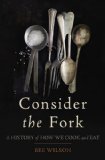Summary | Excerpt | Reading Guide | Reviews | Beyond the Book | Readalikes | Genres & Themes | Author Bio

Critics' Opinion:
Readers' Opinion:
First Published:
Oct 2012, 352 pages
Paperback:
Oct 2013, 336 pages
 Book Reviewed by:
Book Reviewed by:
Poornima Apte
Buy This Book
It was not that spiky fork-like instruments were unheard of before then, but their use was limited to certain foods. In ancient Rome, there were one-pronged spears and spikes for getting at hard-to-reach shellfish, for lifting food from the fire or impaling it. Medieval and Tudor diners also had tiny "sucket" forks, double-ended implements with a spoon at one end and a two-pronged fork at the other. As sugary sweetmeats or "suckets" became more common among the rich, so the need for these forks increased. In 1463, a gentleman of Bury St. Edmunds bequeathed to a friend "my silvir forke for grene gyngour" (candied ginger). The fork end was used to lift sticky sweetmeats out of pottery jars; the spoon end was used to scoop up the luscious syrup. When bits of sweetmeat lodged in the teeth, the sucket fork doubled as a nifty toothpick. But this was not at all the same as a fork in the modern sense—an individual instrument to enable people to eat an entire meal without handling the food.
Forks in our sense were considered odd until the seventeenth century, except among Italians. Why did Italy adopt the fork before any other country in Europe? One word: pasta. By the Middle Ages, the trade in macaroni and vermicelli was already well established. Initially, the longer noodle-type pastas were eaten with a long wooden spike called a punteruolo. But if one spike was good for twirling slippery threads of pasta, two were better, and three ideal. Pasta and the fork seem made for one another. It is a joy to watch a table of Italians eating long ribbons of tagliatelle or fettuccine, expertly winding up forkfuls of pasta, like slippery balls of yarn. Having discovered how useful forks were for eating noodles, Italians started to use them for the rest of the meal, too.
When Thomas Coryate, an Elizabethan traveler, journeyed around Italy sometime before 1608, he noticed a custom "that is not used in any other country," namely, a "little fork" for holding meat as
it was cut. The typical Italian, noted Coryate, "cannot endure to have his dish touched with the fingers, seeing all men's fingers are not clean alike." Although it seemed strange to him at first, Coryate acquired the habit himself and continued to use a fork for meat on his return to England. His friends—who included the playwright Ben Jonson and the poet John Donne—in their "merry humour" teased him for this curious Italian habit, calling him "furcifer" (which meant "fork-holder," but also "rascal"). Queen Elizabeth I owned forks for sweetmeats but chose to use her fingers instead, finding the spearing motion to be crude.
In the 1970s, real men were said not to eat quiche. In the 1610s, they didn't use forks. "We need no forks to make hay with our mouths, to throw our meat into them," noted the poet Nicholas Breton in 1618. On the cusp of the twentieth century, as late as 1897, British sailors were still demonstrating their manliness by eating without forks. This was a throwback, for by then forks were nearly universal.
By 1700, a hundred years after Coryate's trip to Italy, forks were accepted throughout Europe. Even Puritans used them. In 1659, Richard Cromwell, the lord protector, paid 2 pounds and 8 shillings for six meat forks. With the Restoration, forks were firmly established on the table, alongside the new trifid spoons. Not wanting to dirty your fingers with food, or to dirty food with your fingers, had become the polite thing to do. The fork had triumphed, though knives and spoons continued to outsell forks until the early nineteenth century.
The triumph of the knife and fork went along with the gradual transition to using china dinner plates, which were generally flatter and shallower than older dishes and trenchers. When bowls were used for all meals, the ideal implement was a spoon with an angled handle for digging deep, like a ladle (the fig-shaped spoons of the Middle Ages usually had stems pointing upward). A knife or fork with horizontal handles does not sit naturally in the curved structure of a trencher or a pottage bowl. They need a flat surface. Try to eat
something in a deep cereal bowl using a knife and fork, and you will see what I mean; your elbows hunch up and your ability to use the cutlery is severely restricted. Flatness is also necessary for the elaborate semaphore of knife-and-fork table manners that reached their apogee in Victorian times. The plate becomes like a dial, on which you communicate your intentions.
Excerpted with permission from Consider the Fork: A History of How We Cook and Eat, by Bee Wilson. Available from Basic Books, a member of The Perseus Books Group. Copyright © 2012. Further information available at: www.considerthefork.com





The Funeral Cryer by Wenyan Lu
Debut novelist Wenyan Lu brings us this witty yet profound story about one woman's midlife reawakening in contemporary rural China.
Your guide toexceptional books
BookBrowse seeks out and recommends the best in contemporary fiction and nonfiction—books that not only engage and entertain but also deepen our understanding of ourselves and the world around us.